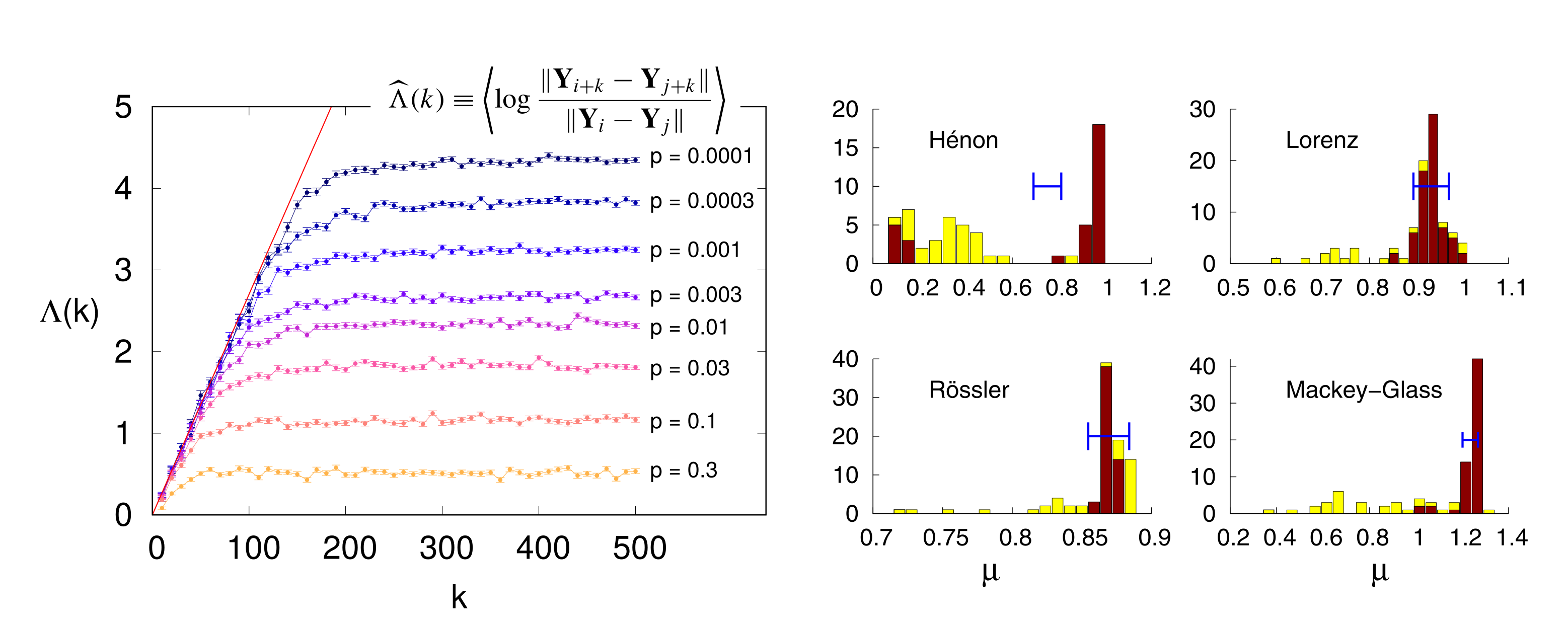Optimal embedding and statistical fluctuations
We studied the statistical properties of one of the most relevant metrics in the field of nonlinear dynamics, namely the maximum Lyapunov exponent (MLE). The MLE is evaluated as the local divergence rate of nearby trajectories by means of the so-called time-dependent divergence exponent. Given a system, embedding methods are often ranked according to how close such MLE values are to the true MLE. We studied the dependence of MLE on the embedding dimension and lag by developing a completely automatic algorithm that provides the divergence rate and its statistical uncertainty. We showed that the search for an optimal embedding choice is fault by statistical fluctuations occurring in the estimation of the MLE. These results were published in:
M. Franchi and L. Ricci, Statistical properties of the maximum Lyapunov exponent calculated via the divergence rate method, Phys. Rev. E 90 (2014), 062920, doi:10.1103/PhysRevE.90.062920


A new approach to optimal embedding
We developed a new method for the identification of suitable embedding parameters. Rather than most conventional approaches, which seek a single optimal value for m and L to embed an input sequence, our approach provides a set of embedding choices that are equivalently suitable to reconstruct the dynamics. The suitability of each embedding choice m, L is assessed by relying on statistical testing, thus providing a criterion that does not require a subjective evaluation of outcomes. The method was successfully applied to synthetic and experimental sequences, providing new insight into the longstanding issue of optimal embedding. For example, the relevance of the embedding window (m-1)L, i.e. the time span covered by each embedding vector, is naturally highlighted by our approach. In addition, our method provides some information on the adequacy of the sampling period used to record the input sequence. The new approach was published in:
A. Perinelli and L. Ricci, Identification of suitable embedding dimensions and lags for time series generated by chaotic, finite-dimensional systems, Phys. Rev. E 98 (2018), 052226 doi:10.1103/PhysRevE.98.052226
An improved estimator for correlation dimension
Another longstanding issue in nonlinear time series analysis is that of distinguishing noise from chaos. To this purpose, a lot of information is provided by analyzing the (usually overlooked) asymptotic (long-time) behaviour of the time-dependent divergence exponent. In particular, the functional dependence of the asymptotic divergence exponent on the distance percentile p used in its evaluation is different whether the source of the sequence is chaotic or stochastic. Moreover, in the case of chaotic sources, this analysis also provides a precise estimate of the system's correlation dimension. These findings were published in:
L. Ricci, A. Perinelli and M. Franchi, Asymptotic behavior of the time-dependent divergence exponent, Phys. Rev. E 101 (2020), 042211, doi:10.1103/PhysRevE.101.042211


Chasing chaos in experimental recordings
We put together all pieces presented above and proposed an alternative approach to the problem of identifying chaos. The core of the new approach is the analysis of an input sequence on a lattice of embedding pairs whose results provide, if any, evidence of a finite-dimensional, chaotic source generating the sequence and, if such evidence is present, yield a set of equivalently suitable embedding pairs to embed the sequence. The application of this approach to two experimental case studies, namely, an electronic circuit and magnetoencephalographic recordings of the human brain, highlights how it can make up a powerful tool to detect chaos in complex systems. This new approach was published in:
A. Perinelli and L. Ricci, Chasing chaos by improved identification of suitable embedding dimensions and lags, Chaos 30 (2020), 123104, doi:10.1063/5.0029333
Electronic implementation of a chaotic system
A crucial issue in nonlinear science is detecting chaos in experimental data. The Minimal Universal Model of chaos, proposed in a recent work, was here implemented on a custom printed circuit board, with digital control of the model's parameters. By finding a relationship between spiking activity and maximum Lyapunov exponent, we selected several parameter settings which could exhibit chaotic behavior. The final proof was provided using the divergence exponent method on the experimental time series, providing values of the maximum Lyapunov exponent in very good agreement with theoretical predictions. These findings were published in:
L. Ricci, A. Perinelli, M. Castelluzzo, S. Euzzor, R. Meucci, Experimental evidence of chaos generated by a Minimal Universal Oscillator Model, Int. J. Bifurcation and Chaos 31 (2021), 2150205, doi:10.1142/S0218127421502059
